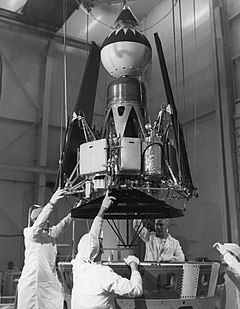 Ranger 4 | |||||||||||
| Mission type | Lunar impactor | ||||||||||
|---|---|---|---|---|---|---|---|---|---|---|---|
| Operator | NASA | ||||||||||
| Harvard designation | 1962 Mu 1 | ||||||||||
| COSPAR ID | 1962-012A | ||||||||||
| SATCAT no. | 280 | ||||||||||
| Mission duration | 10 hours (operational) 64 hours (to impact) | ||||||||||
| Spacecraft properties | |||||||||||
| Manufacturer | Jet Propulsion Laboratory | ||||||||||
| Launch mass | 331.1 kg (730 lb) | ||||||||||
| Dimensions | 1.52 m × 2.51 m (5.0 ft × 8.2 ft) | ||||||||||
| Power | 135 W | ||||||||||
| Start of mission | |||||||||||
| Launch date | April 23, 1962, 20:50:00 UTC | ||||||||||
| Rocket | Atlas LV-3 Agena-B | ||||||||||
| Launch site | Cape Canaveral LC-12 | ||||||||||
| Lunar impactor | |||||||||||
| Impact date | April 26, 1962, 12:49:53 UTC Failed before impact | ||||||||||
| Impact site | 15°30′S 130°42′W / 15.5°S 130.7°W | ||||||||||
| |||||||||||
Ranger 4 was a spacecraft of the Ranger program, launched in 1962. It was designed to transmit pictures of the lunar surface to Earth stations during a period of 10 minutes of flight prior to crashing upon the Moon, to rough-land a seismometer capsule on the Moon, to collect gamma-ray data in flight, to study radar reflectivity of the lunar surface, and to continue testing of the Ranger program for development of lunar and interplanetary spacecraft.
An onboard computer failure caused failure of the deployment of the solar panels and navigation systems; as a result the spacecraft crashed on the far side of the Moon without returning any scientific data. It was the first spacecraft of the United States to reach another celestial body[2][3][4] and the first of any nation to reach the surface of the far side of the Moon.
- ^ NASA, Goddard Space Flight Center. "Experiments on Ranger 4". NSSDC Master Catalog. Retrieved December 3, 2022.
- ^ "National Space Science Data Center - Ranger 4". National Air and Space Administration. Retrieved 19 June 2012.
- ^ "Ranger 4 crashes on Moon". Lewiston Morning Tribune. (Idaho). Associated Press. April 27, 1962. p. 1.
- ^ "Ranger-4 hits moon in new space triumph". Bend Bulletin. (Oregon). UPI. April 26, 1962. p. 1.